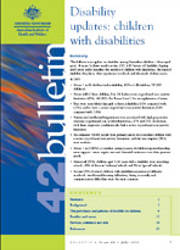Summary
This bulletin is an update on disability among Australian children—those aged up to 14 years. It draws mostly on the 2003 ABS Survey of Disability, Ageing and Carers and it describes the number of children with disabilities, the types of disability they have, their experience in school, and the needs of their carers.
In 2003:
- About 1 in 12 children had a disability (8.3% of all children, 317,900 children).
- About half of these children, 1 in 24, had a severe or profound core activity limitation (4.3%, 165,300). See Boxes 1 and 2 for an explanation of terms.
- Boys were more likely than girls to have a disability (10% compared with 6.5%); and to have a severe or profound core activity limitation (5.4% compared with 3.1%).
- Autism and intellectual impairment were associated with high proportions of severe or profound core activity limitation—87% and 75% of children with these respective conditions also had a severe or profound core activity limitation.
- An estimated 54,600 people were primary carers of co-resident children with a severe or profound core activity limitation; and the vast majority (91%) were mothers.
- About 1 in 2 (48%) co-resident primary carers of children reported needing more support—more respite care and financial assistance were their greatest needs.
- Almost all (97%) children aged 5–14 years with a disability were attending school—89% of them in ‘ordinary’ schools and 9% in ‘special’ schools.
- Around 63% of school children with disabilities experienced difficulty at school—intellectual/learning difficulties, fitting in socially and communication difficulties were the most common.
Background
The prevalence and patterns of disability in children
Families and carers
Services, assistance and aids
End matter: References



